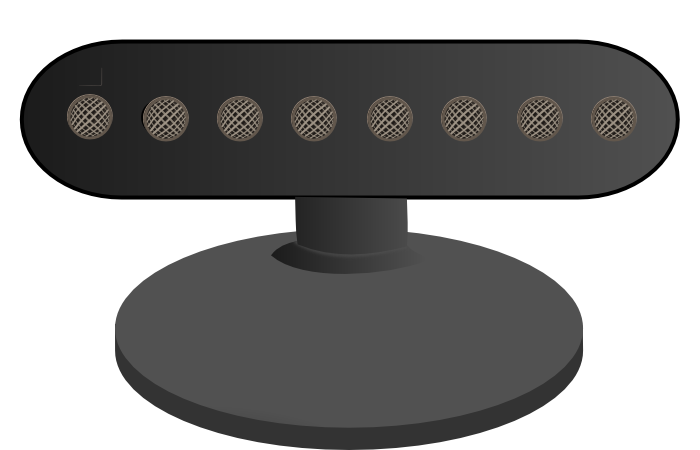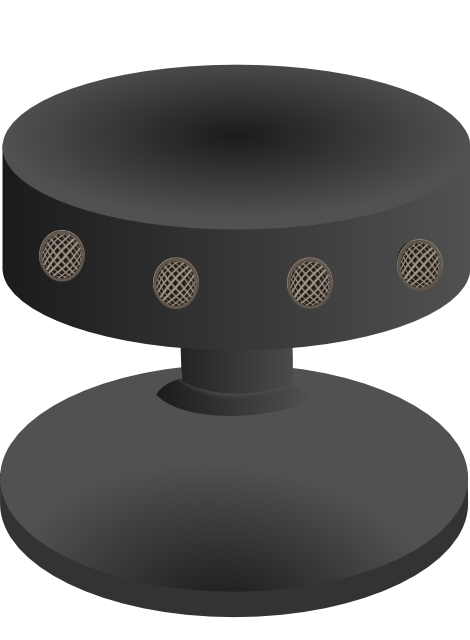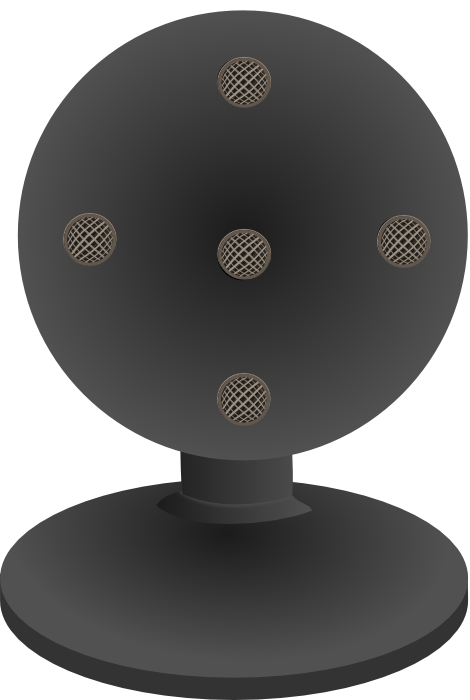
|
vlrPhone |
The VLC and VLR codecs and the Ultrasounds
The vlrPhone Project and the Ultrasounds
The ultrasounds are commonly used in many areas, including in the medical imaging, the motion or presence detection, the leak detection and the distance measurements (the ultrasonic radars).
In recent years, their importance has become growing in the field of the local or near field communications, in particular, thanks to the development of the Internet of Things (IoT).
VlrPhone uses a codec (or rather a family of codecs) compatible with the ultrasounds.
These codecs can take the ultrasounds into account in three ways:
- By increasing the useful audio band. Beyond 20 kHz, the sounds become inaudible for the human ears and are called ultrasounds.
- By taking into account only the areas in the ultrasound.
- By performing frequency shifts towards the ultrasounds.
The examples cited below are of increasing interest:
- The uXDT protocol (Ultrasonic Cross-Device Tracking).
For more information on this protocol, see:
- uXDT
With this protocol, one can for example take advantage of a television program to send non-audio messages (uBeacons) to smartphones, via the ultrasounds.
It should be noted that this protocol raises questions because it may compromise the anonymity or the integrity of the data.
- The gesture recognition, without contact, using the ultrasounds, instead of the infrared.
- The contactless payment using the ultrasounds.
- The indoor positioning system (IPS) or the indoor location service, using the ultrasounds.
- The chargement of the batteries, without contact, using the ultrasounds (at the research stage).
It should be noted that the detection and recognition systems are characterized by a low cost and above all by a very low energy consumption, compared to systems that do not use the ultrasounds.
It should be also noted that the frames of the audio codecs used by vlrPhone can carry audio messages (additional or not) by putting them in the ultrasonic areas. Simple frequency shifts are sufficient to put them in the audible areas.
Remote Monitoring with the Ultrasounds
The monitors for the remote monitoring have the most need of codecs for the recordings.
One can cite:
- The compressed air leak detection (used from the very beginning of the technology)).
- The monitoring of the condition of the bearings and the rotating equipment.
- The condition-based lubrication.
- The electrical inspection of the energized electrical equipment.
The ultrasound are able to detect bearing faults in the early stage.
The ultrasounds can prevent over-lubrication and under-lubrication.
The ultrasounds can be used to inspect almost any energized electrical equipment.
The ultrasounds can be used to measure equipment voltages from the low end (110 volts) to well over 12000 volts (12kV).
Older technologies include the vibration analysis and the infrared thermography (temperature).
An electrical equipment may not produce significant heat that can be detected by an infrared camera. However, it may produce high frequency sounds that can be detected by an ultrasonic monitor.
For more information:
- Remote Monitoring with the Ultrasounds
Ultrasonic Receivers (linear, 360 degrees, spherical)

Broadband ultrasonic receivers, composed of a linear array of 8 microphones.
With the vlrphone project, we will propose receivers for the surveillance and the detection, using the ultrasounds, for use alone or with a classic video camera.
These receivers will record the ultrasounds using the VLC and VLR codecs algorithms, including:
- The basic algorithms (the greatest points and the most energetic bands, or the local peaks).
These algorithms are currently implemented in the Windows version with the PJSIP library. One can get an idea of the quality by visiting the listening page:
- Listen Page
- Optionally, the algorithms used by the VLR codec, notably the possibility of not transmitting or recording successive similar frames up to a certain point.
Since all non-similar or forced frames are numbered, the notion of exact time of recording is preserved. These algorithms are particularly powerful if the frames are identical most of the time.
- Algorithms
- Optionally, later, one will be able to use the algorithms used with the codebook version of the codecs. This involves generating a database with the most frequent vectors of magnitudes and positions.
One will be able to replace dozens of bytes of a compressed frame by one or two integers. For more information, see at the following address:
- Codebook Version
There will be up to ten (10) receivers in the general case, and up to thirty two (32) receivers in option.
We will consider the sampling rates of 48 and 96 kHz in the general case, 192 and 384 kHz in option.
The receivers will be compatible with the projects using the Doppler effect (frequency changes when the distance between the transmitter and the receiver varies over the time), and the projects using the amplitude variations (the receiver is more or less close to the transmitter).
The obtained bitrates will be compatible with certain low bitrate networks for connected objects, such as the LoRa network (Low Range).
These networks, which are also low consumption networks, are called LPWAN (Low Power Wide Area Network).

Broadband ultrasonic receivers, composed of a 360 degree array of 8 microphones.

Broadband ultrasonic receivers, composed of a spherical array of 10 microphones.
The ultrasounds are commonly used in many areas, including in the medical imaging, the motion or presence detection, the leak detection and the distance measurements (the ultrasonic radars).
In recent years, their importance has become growing in the field of the local or near field communications, in particular, thanks to the development of the Internet of Things (IoT).
VlrPhone uses a codec (or rather a family of codecs) compatible with the ultrasounds.
These codecs can take the ultrasounds into account in three ways:
- By increasing the useful audio band. Beyond 20 kHz, the sounds become inaudible for the human ears and are called ultrasounds.
- By taking into account only the areas in the ultrasound.
- By performing frequency shifts towards the ultrasounds.
The examples cited below are of increasing interest:
- The uXDT protocol (Ultrasonic Cross-Device Tracking).
For more information on this protocol, see:
- uXDT
With this protocol, one can for example take advantage of a television program to send non-audio messages (uBeacons) to smartphones, via the ultrasounds.
It should be noted that this protocol raises questions because it may compromise the anonymity or the integrity of the data.
- The gesture recognition, without contact, using the ultrasounds, instead of the infrared.
- The contactless payment using the ultrasounds.
- The indoor positioning system (IPS) or the indoor location service, using the ultrasounds.
- The chargement of the batteries, without contact, using the ultrasounds (at the research stage).
It should be noted that the detection and recognition systems are characterized by a low cost and above all by a very low energy consumption, compared to systems that do not use the ultrasounds.
It should be also noted that the frames of the audio codecs used by vlrPhone can carry audio messages (additional or not) by putting them in the ultrasonic areas. Simple frequency shifts are sufficient to put them in the audible areas.
Remote Monitoring with the Ultrasounds
The monitors for the remote monitoring have the most need of codecs for the recordings.
One can cite:
- The compressed air leak detection (used from the very beginning of the technology)).
- The monitoring of the condition of the bearings and the rotating equipment.
- The condition-based lubrication.
- The electrical inspection of the energized electrical equipment.
The ultrasound are able to detect bearing faults in the early stage.
The ultrasounds can prevent over-lubrication and under-lubrication.
The ultrasounds can be used to inspect almost any energized electrical equipment.
The ultrasounds can be used to measure equipment voltages from the low end (110 volts) to well over 12000 volts (12kV).
Older technologies include the vibration analysis and the infrared thermography (temperature).
An electrical equipment may not produce significant heat that can be detected by an infrared camera. However, it may produce high frequency sounds that can be detected by an ultrasonic monitor.
For more information:
- Remote Monitoring with the Ultrasounds
Ultrasonic Receivers (linear, 360 degrees, spherical)

Broadband ultrasonic receivers, composed of a linear array of 8 microphones.
With the vlrphone project, we will propose receivers for the surveillance and the detection, using the ultrasounds, for use alone or with a classic video camera.
These receivers will record the ultrasounds using the VLC and VLR codecs algorithms, including:
- The basic algorithms (the greatest points and the most energetic bands, or the local peaks).
These algorithms are currently implemented in the Windows version with the PJSIP library. One can get an idea of the quality by visiting the listening page:
- Listen Page
- Optionally, the algorithms used by the VLR codec, notably the possibility of not transmitting or recording successive similar frames up to a certain point.
Since all non-similar or forced frames are numbered, the notion of exact time of recording is preserved. These algorithms are particularly powerful if the frames are identical most of the time.
- Algorithms
- Optionally, later, one will be able to use the algorithms used with the codebook version of the codecs. This involves generating a database with the most frequent vectors of magnitudes and positions.
One will be able to replace dozens of bytes of a compressed frame by one or two integers. For more information, see at the following address:
- Codebook Version
There will be up to ten (10) receivers in the general case, and up to thirty two (32) receivers in option.
We will consider the sampling rates of 48 and 96 kHz in the general case, 192 and 384 kHz in option.
The receivers will be compatible with the projects using the Doppler effect (frequency changes when the distance between the transmitter and the receiver varies over the time), and the projects using the amplitude variations (the receiver is more or less close to the transmitter).
The obtained bitrates will be compatible with certain low bitrate networks for connected objects, such as the LoRa network (Low Range).
These networks, which are also low consumption networks, are called LPWAN (Low Power Wide Area Network).

Broadband ultrasonic receivers, composed of a 360 degree array of 8 microphones.

Broadband ultrasonic receivers, composed of a spherical array of 10 microphones.